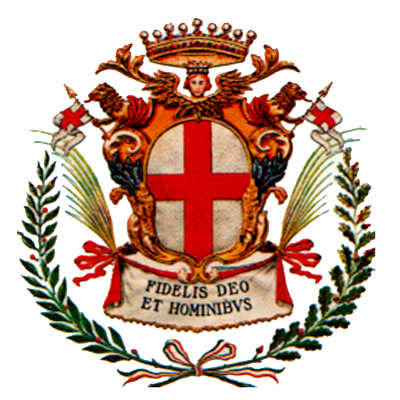Confraternity of the Misericordia - Croce Nera
The church of the Confraternity of the
Misericordia or of Saint John Decollate is referred to by the
people of Savigliano as Crosà Neira because of the habit
worn by confreres, devoted chiefly to assisting the sick and those
condemned to death. It was built to plans by the Lugano architects
Agostino Rusca and Filippo Piazzola, under the supervision of
Giuseppe Fontana of Cuneo. Work commenced in 1614. The church was
composed of a nave with two side altars and a massive bell tower,
the construction of which began in 1664, to plans by the captain
and engineer Giacomo Antonio Biga, but was not completed until
1711-15.
The richly decorated interior poses a contrast to the simple
two-storey façade that takes up the typical
seventeenth-century architectural layout of religious buildings
used for hospitaller confraternities. In the early decades of the
past century the cost of maintaining the building began to rise.
Following a period of financial difficulties, the decision was made
to sell off paintings and artwork. To minimize this dispersion,
around 1950 the church's ornaments, sacred objects and works of art
were delivered to the monastery of San Pietro, where they remain
today. In the 1960s the church - deconsecrated by this time - was
set up as a warehouse and crafts workshop.
In 1984 a municipal ordinance required its demolition, which was
fortunately stopped thanks to the intervention of the Natura Nostra
Association and the Superintendence of Environmental and
Architectural Heritage.
After years of abandonment and deterioration, the building - which
by this time no longer had a roof and had been gutted on the south
side of the nave - was restored between 2005 and 2010, thanks to a
project promoted by the municipal government of Savigliano, based
on plans by the architect Gianfranco Gritella. In the restoration
project, modern architecture was "grafted" onto the
seventeenth-century ruins with a protective covering in steel and
zinc-titanium alloy, reorganizing the spaces while leaving the
traces of the past intact.
A crack created intentionally on the façade serves as a
reminder of the difficult history of the building, which is now a
prestigious multipurpose hall open to the public. The interior
houses the original of the eighteenth-century iron pediment set on
the spire of the bell tower. The work of the Savigliano master
Giorgio Golfi, it depicts the head of John the Baptist surrounded
by a radiate nimbus.

